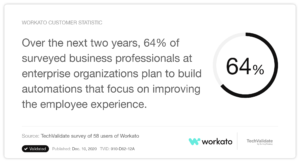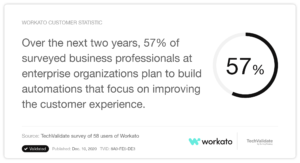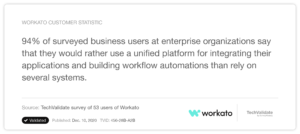In our increasingly digital age, automation is synonymous with driverless cars and robots in the checkout queue. But automation can also mean added assistance in the workplace, especially with menial tasks that you probably wouldn’t want to spend the bulk of your time and productivity on. These functions range from automatically streamlining data to reducing the steps needed to fulfill an action.
Most execs already know that streamlining operations is important — according to an MIT Sloan survey, executives at 91% of companies say digital technologies have the potential to fundamentally transform the way companies work — but exactly how does it transform work? At Workato, we’ve seen how workflow automation has helped companies of all sizes be more productive.
To help you understand how automation can help, we’ll review 15 statistics that showcase how it’s being used today. But first, let’s review 3 forward-looking stats that can give you a sense of where automation is headed.
Related: 10 automation trends to look out for in 2023
Organizations will embrace employee-focused automations
Fact: Over the next two years, 64% of business professionals at enterprise organizations plan to build automations that focus on improving the employee experience.
These automations can vary widely. When it comes to onboarding employees, this may include instantly provisioning new hires with the apps and equipment they need on day 1. When it comes to the day-to-day employee experience, this can take the form of streamlining the process of making requests and approvals (e.g. PTO). And when it comes to offboarding employees, this can be automating the process of removing employees’ access to apps and returning their equipment.
Organizations will look to build customer-centric automations
Fact: Over the next two years, 57% business professionals at enterprise organizations plan to build automations that focus on improving the customer experience.
How, exactly, can automation improve the day-to-day experiences of customers? For starters, you can build automations around product usage data that allow your customer-facing colleagues to identify clients who aren’t using your product effectively. From there, your colleagues can reach out to clients and offer proactive, productive feedback. In addition, you can build a workflow that enables your marketers to easily view the product usage data among clients who sign up for an event (e.g. a marketing webinar). Based on the insights your colleagues glean, they can personalize the event in a way that caters to attendees’ interests.
Beyond product usage data, you can resolve clients issues faster by automating your incident management process, and you can address client feedback quickly by automating the process of collecting and analyzing their responses via surveys.
Organizations will look for a single platform to manage their integration and automation needs
Fact: 94% of business professionals at enterprise organizations say they would rather use a unified platform integrating their applications and building workflow automations than rely on several systems.
Implementing various tools for building integrations and automations, like an iPaaS, an ETL, an RPA, etc. results in various issues:
- It’s expensive, as each tool comes with its own price tag
- It’s difficult to manage internally, as these tools tend to require specialists
- It can lead to wasted time and effort, as employees will have to work across these tools to implement integrations and automations.
An enterprise automation platform like Workato neatly addresses these drawbacks by providing a single platform that allows employees to build integrations AND automations—and do so without having to write a single line of code.
Related: 18 HR automation trends that illustrate how, exactly, HR teams are automating
Automation is an organization-wide initiative
Fact: More than 30% of organizations have 5 or more departments that automate.
Any department can benefit from automation, and with the changes brought on by the pandemic, automation’s appeal has never been greater.
It allows teams to adopt more resilient, innovative processes, enabling organizations to not only power through this “new normal” but to do so successfully: They’re able to deliver more value to key stakeholders, whether that’s clients, employees, or prospects.
Fact: IT and engineering accounts for nearly 40% of an organization’s automations.
While IT and engineering lead the way by a good margin, other teams are clearly automating at a healthy level; finance & accounting come in second, owning just over a quarter of the organization’s automations, followed by sales & marketing (13.3%), HR & payroll (11%), and customer support (9.5%).
Automation transforms key business processes
Fact: 19% of automations fall under order to cash.
Given the role O2C plays in helping organizations collect payments, onboard clients, recognize revenue, and more, this perhaps comes as little surprise. What might be seen as surprising, however, are the other processes that are being automated end-to-end—such as employee onboarding (4%), case to resolution (4%), and campaign operations (3%). Clearly, organizations are buying into the promise of automation and increasingly see it as a success driver.
Related: 11 automation ideas to fuel your team’s brainstorm
Automation-building is a team sport
Fact: 45% of business teams play a role in building automations.
Organizations can no longer afford to rely on IT to build and maintain their integrations and automations. Automating at scale, bringing automations to market quickly, and implementing impactful automations requires bringing in business teams who are intimately familiar with these processes.
To help facilitate this demand and business need, enterprise automation platforms like Workato provide a low-code/no-code UX; moreover they provide enterprise-grade governance and security features, ensuring that IT can still oversee automation operations and ensure that sensitive, business-critical information isn’t at risk of getting compromised.
Automations work across a variety of applications
Fact: Salesforce is used in 23% of all automations.
Given its adoption across business processes and teams, the CRM’s prevalence in automations may not come as a surprise. More interesting, Slack comes in at a close second (20%). This underscores the value organizations see in bringing automations directly to employees—allowing employees to take actions faster and with less effort.
Related: The top finance automation statistics in 2023
Automation supports sales processes
Fact: Less than 1% of B2B organizations call or email an inbound lead within 5 minutes.
Considering that your odds of qualifying a lead decreases by 400% when you delay your response time from 5 to 10 minutes, it’s clear that organizations are leaving a lot of money on the table. With automation, you can intelligently route leads. This means you’re seamlessly sharing leads with reps, and providing them with the information they need from your CRM, an enrichment tool like Clearbit—among other tools—, and sharing it with reps on the platform they’re working on already (e.g. Slack).
Fact: 50% of sales time is wasted on unproductive prospecting.
Sales doesn’t have to be hit-or-miss. You can easily identify quality prospects with the right tools. It all boils down to knowing your customers well—which is key to closing a sale. It’s important to build relationships with your customers by understanding what they need at each point of the buyer’s journey. Mapping lead nurturing content is easy with the right tools that support your goals throughout the sales cycle.
Automation is the glue that holds your MarTech stack together
Fact: 51% of organizations use 21 or more digital marketing solutions, but only 9% of companies have a complete, fully-utilized MarTech stack.
A marketing technology stack is the collective use of specialized technologies for your marketing efforts—from content management and CRM to analytics and social media tools. With the explosion in the development and use of MarTech, it’s clear that companies are discovering the real value of digital marketing solutions. The MarTech space is teeming with apps, but simply using a bunch of apps does not a MarTech stack make. Integration links your marketing apps together and allows you to construct automated workflows, so your marketing workflows happen just as you need them to.
Fact: Email is 40x more effective at converting new customers than Facebook and Twitter combined.
You’d think that with the rise of social media and chat platforms in recent years, email might not be as valuable a tool as it once was. But it still boasts the most significant marketing ROI and conversions—if you update your email marketing strategy. Implementing personalization is made vastly easier by automation, which allows you to use apps like Constant Contact or MailChimp to send well-crafted and highly targeted emails to effectively nurture your prospects.
Automation is effective for social media marketing
Fact: Social media management is just one of numerous work responsibilities for as much as 64% of marketers.
Automation allows marketers to spare some time in their busy schedules. According to NapoleonCat, by automating 50% of social media moderation, teams can save up to 175 hours a month.
Fact: Marketers can save 6 hours a week by automating their social media content and ads.
Automation allows marketers to schedule organic and paid content. This means that they can simply prepare all content in advance, at their convenience, and don’t have to worry about publishing the posts at the right time. This is a huge help, especially if you cater to international audiences or run multiple social media profiles.
Multitasking comes with a steep price tag
Fact: 40% of productivity is lost to task-switching.
We may try to juggle as many projects or tasks as possible, but in the end we’re only human. In fact, studies have shown that we are inherently bad at multitasking; our brains are simply wired to focus on one thing at a time. But many workflows require that we work within multiple apps simultaneously.
Customer service agents, for example, straddle apps such as Zendesk, Salesforce, and Intercom to triage and resolve tickets. With automation, you can streamline data across these apps, optimizing agents’ time by increasing visibility and centralizing their work. You can even use bots to perform tasks from your preferred hub, such as Slack.
Fact: 97% of employees and executives believe that a lack of alignment within a team impacts the outcome of a task or project.
At any successful company, teams and departments run like well-oiled machines. Collaboration is key to functioning well—and that means keeping up with changes between departments. Automation effectively supports modern teamwork by making it easy to get everyone on the same page (and keep them there!), from syncing departmental apps to automating long process like onboarding and reporting.
Fact: 73% of Customer Support professionals report that managing time and workload was the biggest issue faced in customer support.
As the frontline of the customer experience, Customer Support professionals face their fair share of challenges. They’re constantly bombarded with tickets to resolve, and unhappy customers to pacify—not to mention all the apps they need to juggle on a daily basis. A possible consequence? Burn out. Automation can definitely make their jobs easier, simply because they have fewer processes to execute, whether it’s accessing the right customer information or accurately triaging a large volume of tickets.
Related: 5 support automation stats that show how the function is evolving
Automation eliminates manual data entry
Fact: Office-based professionals spend more than 50% of their time searching for files manually.
Silos exist because of a lack of communication between teams or due to poor organization in the form of incorrectly filed documents or lost data. Sometimes, we may even spend more time manually recreating a duplicate, thinking we’ve lost the original. This tedious process comes at a cost, wasting precious time and inhibiting productivity.
With automation, however, we can eliminate the admin work we all spend too much time doing—and reduce app silos in the process! For example, it allows you to automatically streamline data between a CRM (like Salesforce) and an accounting program (such as NetSuite)—no more manually adding invoices to opportunities! And automation also simplifies searching for, retrieving, and archiving data.
Despite all the benefits that come with automating, many organizations have yet to streamline their key workflows. You can learn more about the automations that are gaining adoption and those that aren’t by downloading The State of Automation report!



